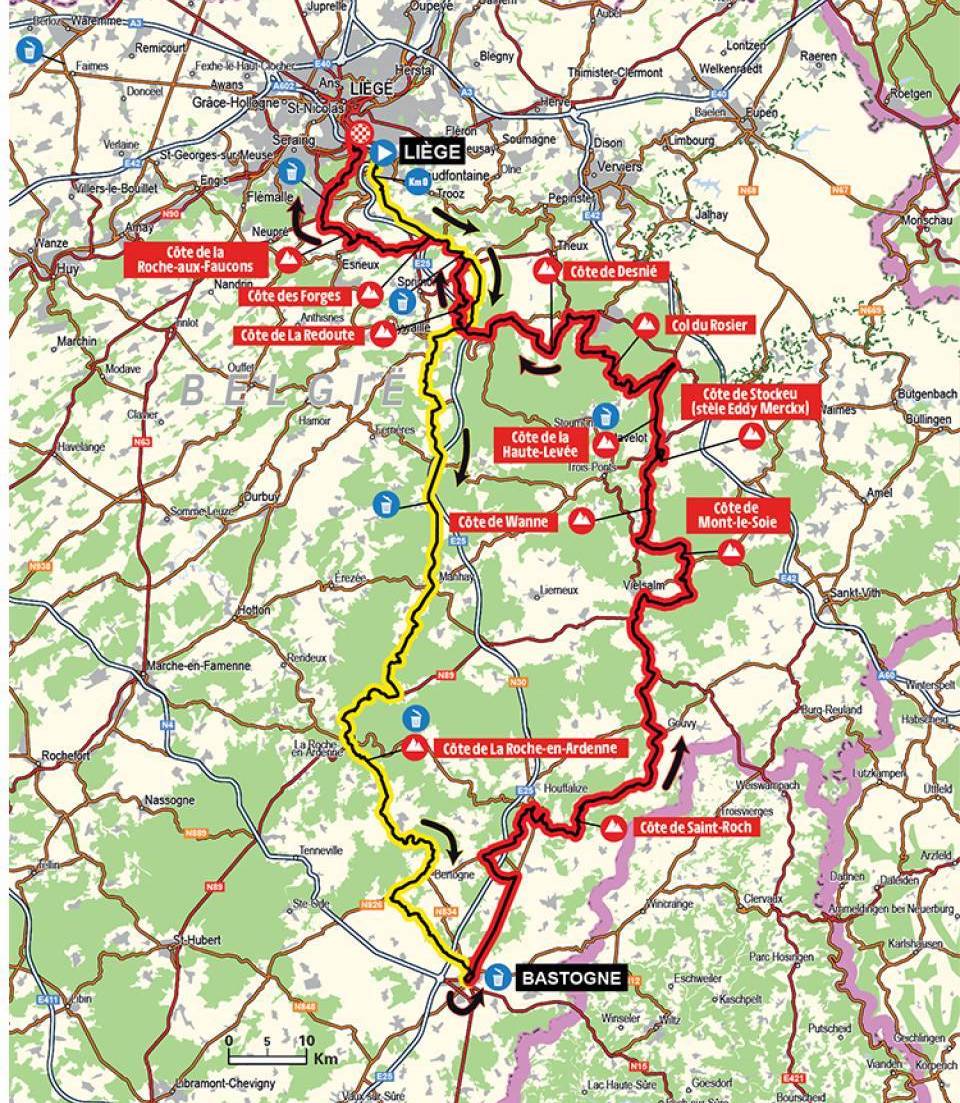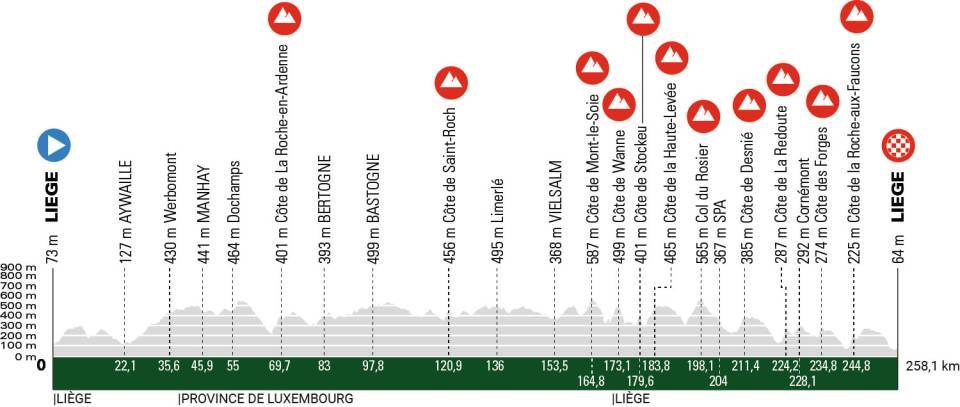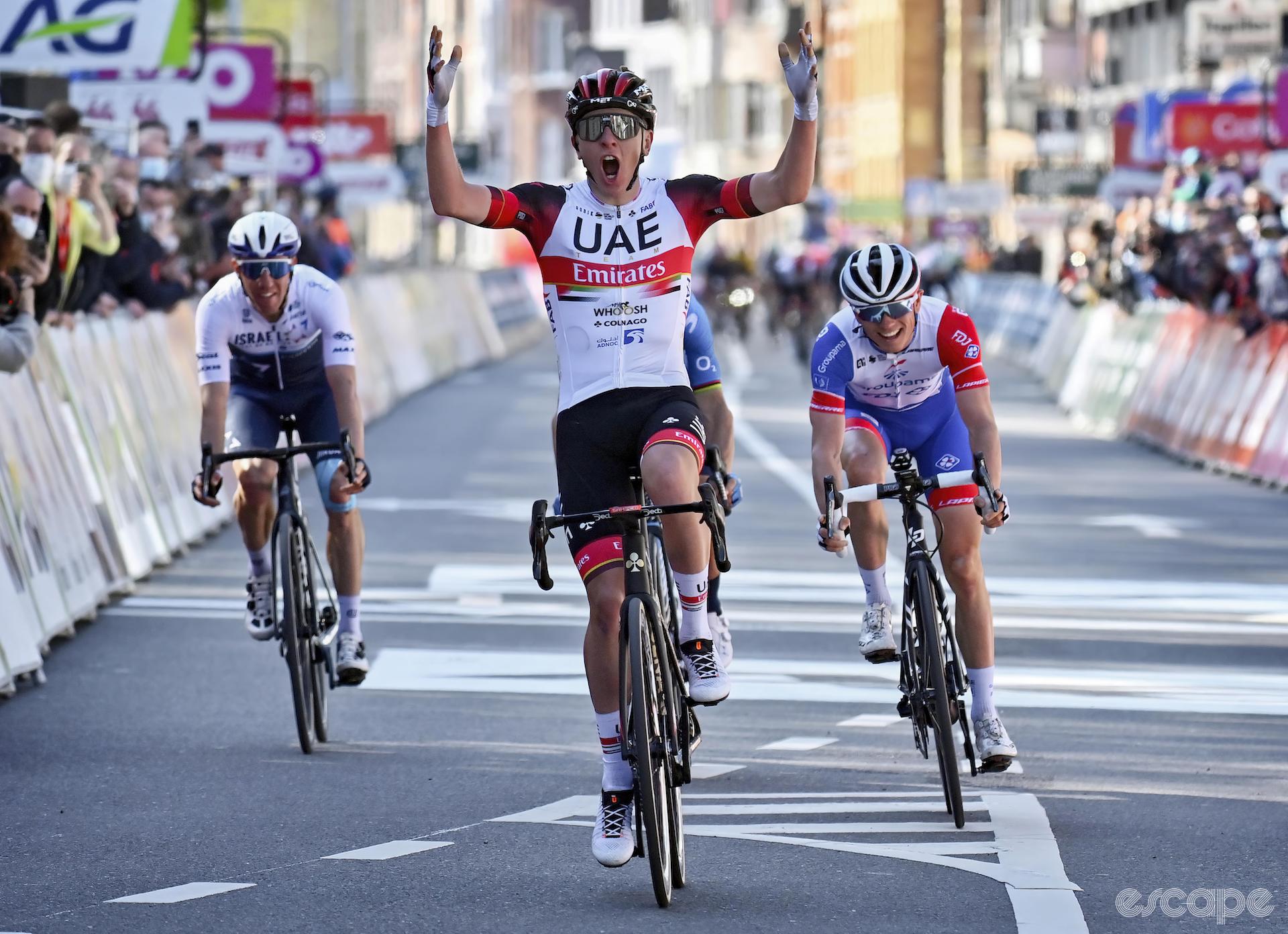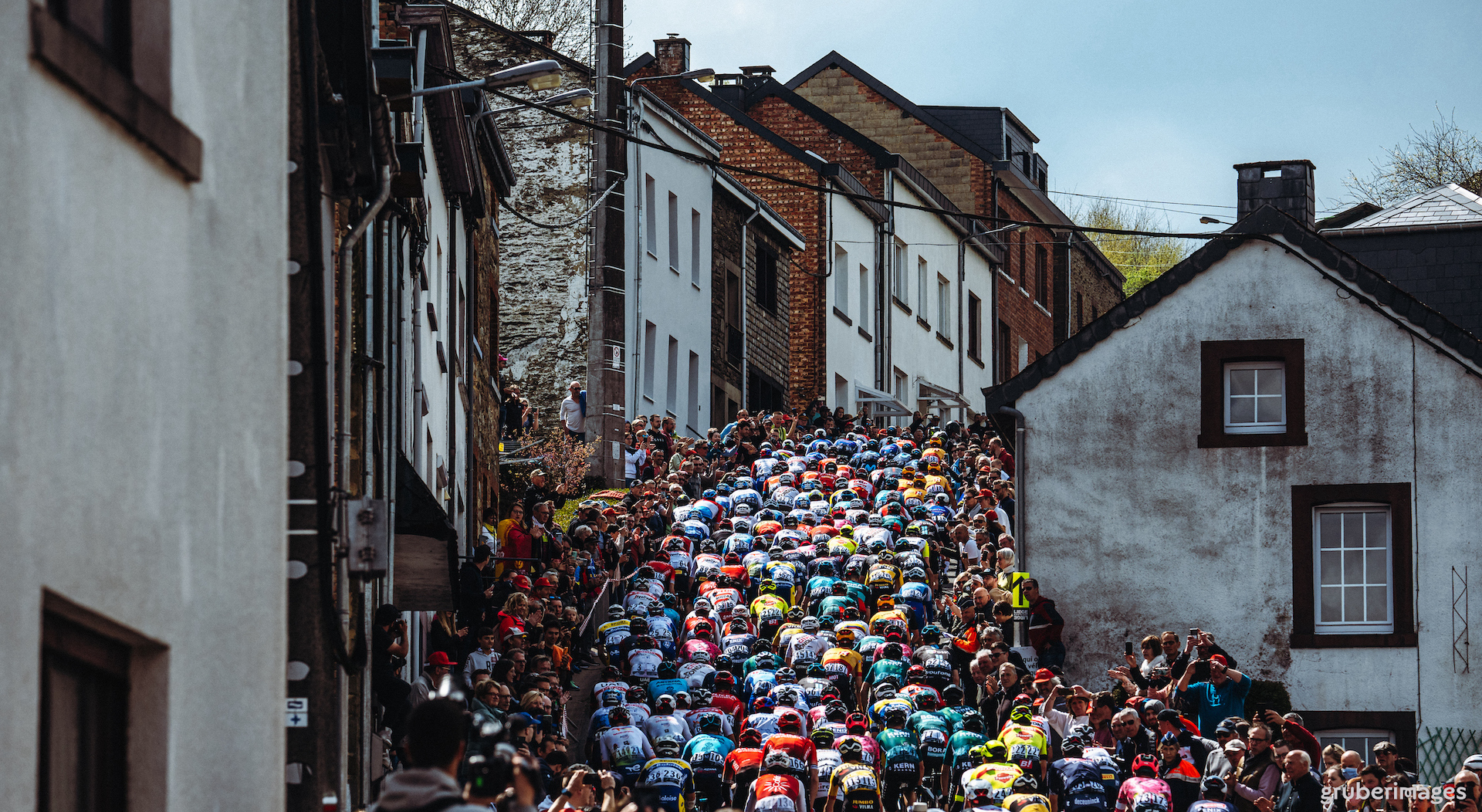The climax of the Ardennes Classics, and the finale of the Spring Classics in general, is nearly upon us. Liège-Bastogne-Liège will crown its 109th men’s champion on Sunday, marking the final opportunity for the one-day stars to nab a major victory in the European spring. There is no shortage of storylines ahead of “La Doyenne,” one of the oldest bike races in the world. Can anyone stop Tadej Pogačar? What about defending champ Remco Evenepoel?
As ever, Escape Collective is here to preview the action. Abby Mickey will have her preview of the women’s race, and you can read onward right here for all of the key info that you need to know – and maybe even a few things that you didn’t know you needed to know – ahead of the men’s race …
What you need to know
Here are the fundamentals: Liège-Bastogne-Liège will get underway at 10:35 am local time in Belgium (4:35 am ET / 9:35 am BST / 6:35 pm AEST). The expected finish time is around 4:53 pm local time (10:53 am ET / 3:53 pm BST / 12:53 am AEST), though it’s a long enough race where small changes in average speed can make a big difference in the total race time, so that’s very much an estimate.
Unlike Wednesday’s La Flèche Wallone, Liège-Bastogne-Liège could very well be decided with an attack well before the final few hundred meters, so you should probably tune in for at least the last hour and 15 minutes or so.
The route
Race organizers have tinkered with the route here and there in the past (and they should get some credit for making changes that have generally made things more interesting recently) and yet the general idea remains. The race will take the peloton on a southward journey from Liège to Bastogne before heading north back to Liège. Along the way, riders will take on some short but very hard climbs in the Ardennes Forest.

From start to finish, the men’s race will traverse 258.1 km, and during that journey, riders will go up and over 11 official climbs, with nine of those coming in the second half of the day.
The final three climbs will be especially critical, starting with the iconic Côte de la Redoute at around 34 km to go. Evenepoel made his race-winning attack on the climb last year, but it’s slightly farther from the finish this season, and this time, there’s the Côte des Forges to follow.
After that, the riders will tackle the very steep Côte de la Roche aux Faucons. The 11% average gradient is no joke; it makes the climb steeper on average than the Mur de Huy, which is roughly the same length at 1.3 km. “Falcon Rock” is also a spectacular name, so it gets cool points for that too.
Following the top of the Roche aux Faucons is a quick downhill into another uphill stretch, and then roughly 10 km of mostly downhill racing to the line. It’s far enough out that it won’t be easy for an attacker to hold on over the full distance to the finish, but that probably won’t stop some big names from trying and likely succeeding, given how so many of the Spring Classics have gone so far.

As if the climbs weren’t hard enough, the weather will likely add an additional obstacle on Sunday. As of publication time, the forecast for the region calls for substantial rainfall in the afternoon, with high temperatures of around 13 °C (55 °F). The wind may be a factor as well. Based on the current forecast, riders are likely to face a cross-headwind for the final two climbs before changing direction and benefitting from a tailwind (which would favor an attacker) for the final push to the line.
The 2021 winner vs the 2022 winner
We’ll be generous enough to at least name a few outside favorites but we’d be lying if we said anyone other than Pogačar or Evenepoel has a strong chance of winning this race.
Let’s start with Pogačar, who is vying to become the first male rider since Philippe Gilbert to win the Ardennes Triple of the Amstel Gold Race, La Flèche Wallonne, and Liège-Bastogne-Liège (Gilbert did it in 2011). The two-time Tour de France winner has the form and ability to climb away from pretty much any field of rivals, full stop. Plus, he won this race in 2021, so he knows what he’s doing. That makes him the obvious favorite ahead of the race.
That said, he is not so obvious a favorite as you might think, simply because the Liège route will provide a bit more complexity than what we saw at La Flèche Wallonne. For one thing, any one of the late climbs could be a springboard for a long-range strike, and it’s at least possible that an enterprising attacker could outfox Pogačar and UAE-Team Emirates and hold on all the way. Remco Evenepoel won last year’s race with a move from afar, and the time-trialing star has the engine – and the form, based on what we’ve seen so far – to be a serious contender again as he tries to defend his title.
Pogačar might also find it challenging to win if his rivals manage to stick with him and force a potential reduced sprint. As Tour winners go, he’s got a great kick, but head-to-head against Evenepoel or one or two other potential favorites at the end of this long race, he might find it more challenging to nab what would be his second Liège win and fifth career Monument title.

As for those one or two other potential favorites? Let’s mention Flèche Wallonne runner-up Mattias Skjelmose of Trek-Segafredo and Strade Bianche winner Tom Pidcock of the Ineos Grenadiers. Skjelmose, just 21 years old, is a fast-rising talent who is clearly ready to show the world that he belongs in the favorites conversation in climber-friendly races, and really, who knows what his ceiling is at this point? As for Pidcock, he is still working his way back to peak form, but if he can find something close to that by Sunday, he’ll be a major threat.
The Escape Collective star ratings
⭐⭐⭐⭐⭐: Tadej Pogačar
⭐⭐⭐⭐: Remco Evenepoel
⭐⭐⭐: Tom Pidcock
⭐⭐: Mattias Skjelmose, Julian Alaphilippe, Michael Woods, Romain Bardet, Sergio Higuita
⭐: Quinten Hermans, Alexey Lutsenko, Richard Carapaz, Tiesj Benoot, Matej Mohorič, Neilson Powless, Ben Healy
The conversation
Dane Cash: So, Abby, in the last two Monument previews I wrote, I mentioned a “big two,” or a “big three.” We keep coming back to this topic in our conversations. This time, however, where I see at least some semblance of a two-horse race, you see a clear singular favorite.
Abby Mickey: I think looking at this start list and taking into account both the Amstel Gold Race and La Flèche Wallonne, it is really hard to look past Tadej Pogačar here. I think that of any of the three races, if there is going to be a race where he could be defeated, it is this race – but look, if you include Flanders, he’s on a winning streak right now that just seems like he’s unmatched.
DC: I think you’re right though to say that if any of the three, it’s just this one where he might not win, particularly compared to Flèche. There are multiple opportunities to attack in this race. There’s a trio of climbs inside the last 40 km where a rider could get away, and I don’t think you can discount Evenepoel, who has also been really, really strong this year. I don’t like his chances quite as much as Pogačar’s but I do think he’s a strong-enough contender where I won’t be even a little bit surprised if he wins.
AM: I mean, he has had a couple of really good performances. Obviously he won the UAE Tour and got second in Catalonia, where he won multiple stages. But those also aren’t one-day races. He’s gearing up for the Giro, and he’s done three stage races this year, and one-day races are just a completely different animal. I just don’t think that he has the kind of fitness to be able to compete against Pogačar in a race like this. Evenepoel has been on a different trajectory this year.
DC: That’s a good point. The trajectory of a Grand Tour contender is definitely different. Then again, I think this race will be hard to control for UAE, which means that I do think it won’t be as easy for Pogačar to just crush everybody – so I think “the field” has a much better chance here than it did at Flèche, with Evenepoel the likeliest challenger there. In any case, is there anybody else in the field that you’re eyeing as a potential spoiler?
AM: I really like how Mattias Skjelmose is riding at the moment and I think that this would suit him more than Flèche Wallonne did, and he was second there. I also really like David Gaudu but I just, I don’t know – I just don’t think there’s anybody on the roster who is going to be able to compete against Pogačar. To me, if you look at the hierarchy of how this race is gonna go, it’s like Tadej Pogačar at the top, and then two steps down it’s Evenepoel, and then there’s like a cavern and then 10 other guys.

The Escape Collective picks
Dane Cash: Tadej Pogačar
Abby Mickey: Tadej Pogačar
Caley Fretz: David Gaudu
Ronan Mc Laughlin: Tadej Pogačar
Matt de Neef: Tadej Pogačar
Jonny Long: Attila Valter
Kit Nicholson: Tadej Pogačar
What you didn’t know you need to know
Fittingly for one of the most historic events in cycling, Liège-Bastogne-Liège takes the pro peloton into a place with a rich history spanning millennia. To close out the preview, here are just a few notes on the region’s distant past, recent past, and present culture that we hope will help you get into the atmosphere of racing from Liège down to Bastogne and back up to Liège.
Let’s start with the town whose name shows up in the race title twice! Liège in the Middle Ages was a hallmark example of a fascinating medieval political construct: the Prince-Bishopric. In the 10th century, Bishop Notker of Liège was rewarded for his loyalty to Holy Roman Emperor Otto II (ruler of huge swaths of what are now Germany, northern Italy, and other adjoining regions) with the lordship of the County of Huy. Yes, it’s that Huy, the same town visited by La Flèche Wallonne!
From that point on, the feudal lordship of the area was tied to the position of bishop, and subsequent bishops would go on to acquire more territories. For hundreds of years, the Bishop of Liège would also control a rapidly expanding feudal holding like any other prince of the realm would, and that arrangement seemed to work out well enough for the residents of the region, as the Prince-Bishopric became a wealthy center for culture and learning.
Fast forward a few hundred years, and Liège would be at the core of Wallonia’s booming industrial economy in the young nation-state of Belgium. A hundred years or so after that, the region would be the scene of some of the most pivotal engagements of the Western Front in the Second World War, with the midway point of the bike race – Bastogne itself – being right at the heart of the final major Nazi offensive of the war. As the Soviet Union turned the tide on the Eastern Front, the Nazi high command decided to make an attempt to halt the Allied advance to the west in an effort to extract a separate peace with the non-Soviet Allied powers.
The German army made a surprise attack on Allied positions at the end of 1944 as part of a push to try to retake the city of Antwerp. American forces in the Ardennes Forest endured an all-out offensive for weeks. German forces pushed westward (with their battle line bulging into the Allied line) in the snow-covered woodlands and besieged Bastogne, but they were ultimately repelled, albeit at great human cost. By the end of January 1945, the Allies had won what would become known as the Battle of the Bulge, clearing the way for the final push into Germany.
These days, the Ardennes Forest is finally recovering from the shelling of 1944 and 1945. Meanwhile, the people of the region and of Wallonia in general are attempting to reinvent their economic approaches, focusing less on coal and steel and more on tech and tourism in the 21st century.

With all that history covered, you’re probably wondering how you can fuel yourself in a culturally relevant way while watching the race. After that earlier explanation of the Prince-Bishopric of Liège, let’s dive back into the ecclesiastical realm … but this time, with beer! We mentioned Westmalle and Westvleteren Trappist beer during the cobbled Classics, but Wallonia is an abbey beer lover’s paradise too, with the Trappist breweries of Orval, Chimay, and Rochefort leading the way. Rochefort, in particular, is about 30 km as the crow flies from the first climb of the race, the Côte de La Roche-en-Ardenne.
While you sip on a strong Belgian ale on Sunday, you can could consider enjoying any number of foods covered in Sirop de Liège, which is a sort of jammy syrup or syrupy jam, depending on how you want to look at it, made from tree fruits like pears and apples. It’s quite a versatile spread, making a fine accompaniment for Liège waffles or for meat, or on top of bread with cheese. Bon Appétit!
What did you think of this story?

